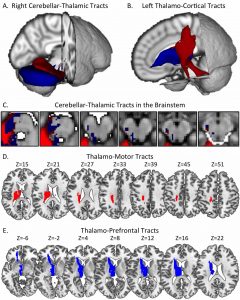 Figure from Bernard et al., 2016, NeuroImage demonstrating white matter tracts connecting the cerebellum and cortex.
Figure from Bernard et al., 2016, NeuroImage demonstrating white matter tracts connecting the cerebellum and cortex.
Rule Learning and the Cerebellum in Older Adults
Using functional MRI we are investigating how the cerebellum is involved during the learning of non-motor rules in young and older adults. We are able to investigate changes in activation over a short period of time, as participants better learn new rule associations. Importantly, we are also considering how the cerebellum interacts with other regions of the brain during the learning process. This study asks participants to spend about 1 hour in the MRI scanner while they learn this new task. Information about participating is available here: CblmLearnFlier
Aggie Aging Brains Study: Longitudinal Brain Changes Across Midlife and Older Adulthood
As we get older, our behavior and brains begin to change. Many older adults may begin to experience changes in their memory and attention or in how well they move. Understanding how changes in the brain are related to these changes in behavior may help us develop future interventions that can improve quality of life and health for aging individuals. The Aggie Aging Brains Study is investigating individuals across adulthood over two years to track changes in both behavior and in the brain. We are particularly focused on understanding the cerebellum as it is a key contributor to motor and cognitive function; however, we are also looking at how this key region interacts with the rest of the brain. Participants complete a brain imaging scan lasting about 1 and a half hours where we collect strucutral and functional information, and ask participants to perform two tasks. In addition, we are asking participants to complete a behavioral test session where they will perform tests of balance and motor function, as well as tests that look at memory and cognition. Information for interested individuals can be found here: LongAgeDevFlier_Amend
Cerebellar and Prefrontal Contributions to Cognition and Motor Behavior
The cerebellum and prefrontal cortex have both been implicated in cognition, and motor behavior. We rely on cognitive processing to learn new motor tasks. There are white matter connections between the cerebellum and prefrontal cortex (via the thalamus) that may result in important interaction between these regions during the performance of motor and cognitive tasks. As we seek to better understand the role of the cerebellum in non-motor task processing it is important to consider the role of these regions together. Is the cerebellum playing just a supporting role while the prefrontal cortex takes the lead in processing? Do both regions contribute equally? Do these relationships differ over the time course of performing or learning a task and across the lifespan? To investigate this we are using a form of non-invasive brain stimulation called transcranial direct current stimulation (tDCS). The stimulation is applied over the prefrontal cortex or the cerebellum and then participants are asked to perform a variety of different tasks both motor and cognitive. All participants will complete two days of testing to compare stimulation conditions. More information about participating in this study can be found here: tDCSLearningFlier_Amendment
Cerebellum and Psychosis
The LCMN is also interested in how the cerebellum contributes to psychosis. This work is done either in collaboration with the ADAPT Laboratory directed by Dr. Vijay Mittal at Northwestern University, or take advantage of publicly available datasets. I primarily investigate cerebellar networks in patients at ultra-high risk for psychosis and how these networks change over time with respect to disease. In patients with schizophrenia I look at cerebellar structure, function, and networks more broadly.